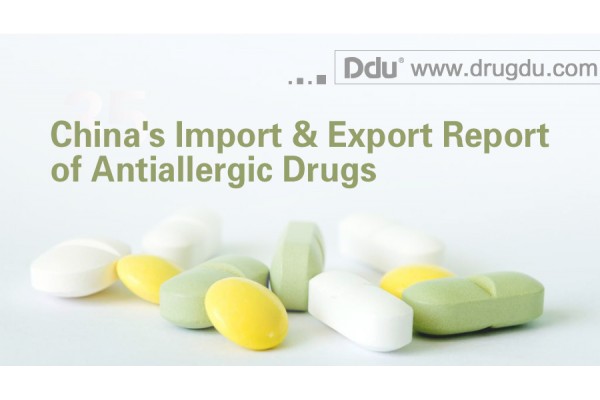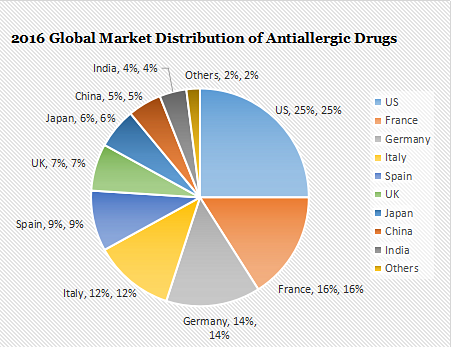Ddu College–China’s Import and Export Market Report of Antiallergic Drugs
December 1, 2017
Source: Ddu
 6,604
6,604

1. Antihistamine drugs: loratadine, promethazine and chlorpheniramine etc.
2. Allergic medium blockers: sodium cromoglycate, ketotifen etc.
3. Others: ① calcium salts, such as calcium chloride, calcium gluconate; ② herbal desensitizer, such as injectiondermatophagoides farinae; ③ glucocorticoid etc.
Allergies, also known as allergic diseases, are a number of conditions caused by hypersensitivity of the immune system to something in the environment that usually causes little or no problems to most people. These diseases include hay fever, food allergies, atopic dermatitis, allergic asthma and anaphylaxis. Symptoms may include red eyes, an itchy rash, sneezing and a runny nose, shortness of breath or swelling. Food intolerances and food poisoning are separate conditions.
Today, Ddu, the leading global pharmaceutical and medical device B2B online platform, will share China’s Import and Export Market Report of Antiallergic Drugs with you.
I. General situation of global market of antiallergic drugs
According to the statistics of WHO, the global antiallergic drugs market was 5.215 billion USD in 2016, of which anti-histamine drugs accounted for 66%, allergic mediator products accounted for 20% and other anti-allergic drugs accounted for 14%.
Antihistamine drugs, the most widely used pharmaceutical drugs in clinical application, treat allergic rhinitis and other allergies. Antihistamines provides relief from nasal congestion, sneezing or hives caused by pollen, dust mites or animal allergies.

In 2016 the top 5 antihistamines used in the world were desloratadine citrate disodium tablets, loratadine, ebastine, levocetirizine and cetirizine.
In the past few years most transnational pharmaceutical companies have devoted themselves to the development of antitumor drugs, antivirus drugs, rare drugs and targeted drugs rather than the development of antiallergic drugs resulting in a sluggish market.

As indicated by the statistics above, eight out of ten of antiallergic drug sales were flat or falling and no sales exceeded one million USD in 2016.
In addition to this, the sales for Singulair, the blockbuster medication from MSD, topped the list with 0.9 billion USD. Singulair was approved for the treatment of anaphylactic rhinitis and asthma, becoming a highly recommended drug for treatment guidelines in many countries.

Currently, the key antiallergic drug markets are the United States, France, Germany, Italy, Spain, the United Kingdom, Japan, China and India and this is expected to grow.
Foreign-funded brands take up major shares in the global antiallergic drugs market. Loratadine, antiallergic drug from Schering-Plough in the United States, is currently being sold in over 110 countries and regions as a non–prescription drug, becoming the best-selling antiallergic drug in the world.
II. China’s antiallergic drugsmarket

According to the statistics of PDB, China’s overall antiallergic drug sales were 5.2 billion RMB in 2016, with an increase of 5.1% over the previous year.
The top ten companies in the antiallergic drugs market are mostly domestic funded companies and account for 51.6% of market shares with relatively high market concentration.

There were four foreign-funded companies. Bayer HealthCare, with its products being very popular in the retail market, ranked first for two consecutive years , which shows an increasing trend in 2017.
There were six domestic-funded companies. Yangtze River Pharmacy and Hainan Poly Pharmaceutical ranked second and third with market shares of 8.1% and 6.4% , which also shows an increasing trend in 2017.

Claritin (loratadine tablets) held dominant position and ranked first for two consecutive years with a stable market share of 10.3% in 2015 and 10.5% in 2016. Desloratadine citrate disodium tablets from Yangtze River Pharmacy, ranked second for two consecutive years with a market share of 5.1% in 2015 and 6.8% in 2016. There was fierce competition among the other top ten brands.
III. General situation of China’s antiallergic drug imports
Loratadine tablets took up most of China’s imported antiallergic drug shares with the main products being Claritin from Byers Healthcare and Astemizole from Johnson & Johnson.
According to the statistics of China customs, China mainly imported antiallergic drugs from France, the United States and Switzerland as indicated on the chart below.

IV. General situation of China’s antiallergic drug exports
As the Chinese pharmaceutical drugs market is integrating with the world market, the product structure of antihistamines, especially piperidines, monoethanolamides, alkyl amine, phenothiazines and piperazine, have gradually improved. What’s more, with product upgrades, first generation antihistamines have been developed to third generation antihistamines, accelerating the export of these drugs.
According to the statistics of China customs, China’s antihistamine drugs were mainly exported to Spain, the United States and Belgium in 2016 and export sales of top 10 counties totaled 21.06 million USD.

V. Leading antiallergic drug companies
Hainan Poly Pharm., Ltd.

Hainan Poly Pharm. Co., Ltd. is a leading international Chinese pharmaceutical preparation company.
Representative product: Desloratadine tablets
Indication: Anaphylactic rhinitis
Main exporting countries: Germany, Holland, France
Yangze River Pharmaceutical Group

Founded in 1971, YRPG is a giant national cross-regional pharmaceutical group, integrating research, manufacturing and trading. It is listed as one of the first innovative enterprises by China MIIT.
Representative product: Desloratadine citrate disodium tablets
Indication: Anaphylactic rhinitis
Main exporting countries: EU, US
Zhejiang Wolw bio-pharmaceutical Co., Ltd
![]()
Zhejiang Wolw bio-pharmaceutical Co., Ltd has the largest allergen drug development base in Asia and is China's largest desensitization drug manufacturer.
Representative product: Dermatophagoides farinae drops
Indication: Dermatophagoides farinae allergy
Main exporting countries: Asian-Pacific region
VI. OTC antiallergic drugs are to be the next blockbuster.
With more investment in the market and an increasing awareness by users, the OTC market has become favored by more and more pharmaceutical manufacturers.
In terms of the domestic market, antiallergic drugs are rarely seen in the OTC market and manufacturers still need to step up their consumption guidance efforts. However, with the improvement of self-treatment, antiallergic pharmaceutical drugs are expected to take up a greater share in the OTC market and become the new main force within the next two to three years.
Thus, Ddu, the leading global pharmaceutical and medical device B2B online platform, advises domestic companies to adapt to market demands with diversified products and seize the opportunity to upgrade the structure of products and devote themselves to the development of drugs that help adjust the immune system and alleviates allergy symptoms.
By DduRead more on
- China’s Import and Export Market Report of Vitamins August 26, 2021
- China’s Import and Export Market Report of Rheumatoid Arthritis Drugs August 26, 2021
- Food Allergen Detector at $40 June 27, 2018
- Glenmark Files an Application to the USFDA for its Nasal Spray May 22, 2018
- What’s Driving the Global Surgical Robotics Market February 26, 2018
your submission has already been received.
OK
Subscribe
Please enter a valid Email address!
Submit
The most relevant industry news & insight will be sent to you every two weeks.



